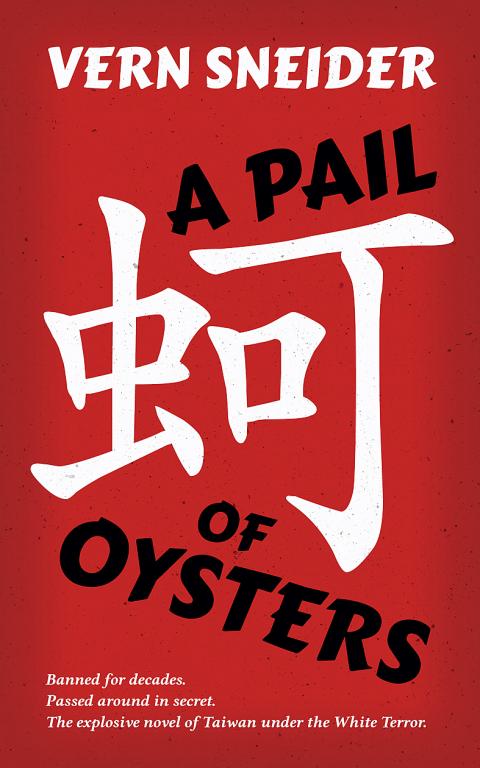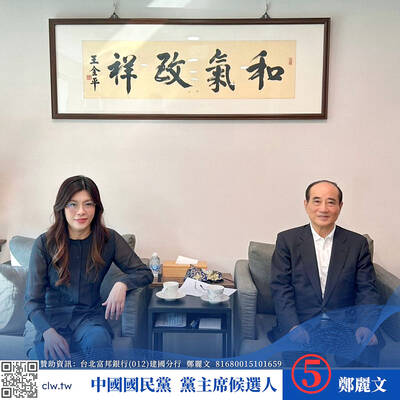Hot on the heels of the success of his debut novel, The Teahouse of the August Moon, American author Vern Sneider spent the summer of 1952 in Taiwan researching his next book.
Ushered in by the 228 Incident of 1947, the White Terror era was at its most brutal at that time as thousands of suspected political dissidents were imprisoned or executed by the ruling Chinese Nationalist Party (KMT).
The resulting book, A Pail of Oysters, was banned in Taiwan, but to Sneider’s dismay, even the US denounced it. It was the McCarthy era, and anything portraying the KMT in a negative light was inevitably painted as pro-communist. It went out of print shortly after.

Photo courtesy of camphor press
While Mandarin and Hoklo (commonly known as Taiwanese) translations have been available since 2003, English editions are rare (rumor has it that pro-KMT students hunted down and destroyed copies from US libraries), with Abebooks.com just listing six copies, ranging from about NT$900 to NT$3,800.
“It’s one of those books that were passed around in secret during the bad old days,” Taiwan and UK-based Camphor Press cofounder Mark Swofford says.
Camphor Press is today releasing the first republishing of the book since the 1950s in digital format, with a print edition to come soon.
“It was suppressed and never got a fair hearing. We want to give it one,” Swofford says.
The book depicts life during White Terror through a variety of characters — most prominently Li Liu, a half-Hakka and half-Aborigine whose family is robbed by KMT soldiers at the beginning of the novel.
But bashing the KMT isn’t the point of the novel, Swofford says.
“It’s a very complex novel, [written] when many people thought it was just the communists versus the KMT,” he says. “It was more of a middle way sort of thing; from the standpoint of the Taiwanese people.”
RE-INTRODUCTION
Late last year, Jonathan Benda, a lecturer at Boston’s Northeastern University, found himself interviewing Sneider’s 85-year-old widow, June.
Benda was familiar with A Pail of Oysters. He read it during his 18-year stay in Taiwan and published an academic paper on it in 2007. Benda says he had once considered republishing it, but lacked the means to do so — and was surprised when Camphor Press asked him to write the introduction to their new edition.
Benda was eager to learn more about the book. In addition to speaking to June, he also dug up old articles and correspondences and obtained copies of the author’s notes through his hometown museum in Monroe, Michigan.
Stationed in Okinawa and Korea, Sneider had never been to Taiwan before the summer of 1952, but the US Army had him study the country at Princeton University in preparation for possible military occupation during the war.
Benda was impressed with the amount of research Sneider’s notes contained — including interviews with people ranging from then-governor K.C. Wu (吳國楨) to pedicab operators and extensive notes on items such as how children are named and blind masseuses. He even had his palm read, which is featured in the novel.
“It’s easy to point out mistakes or problems with his depictions … but I come away thinking that he got a lot of it right,” Benda says.
Through examining letters, Benda found that Sneider had hoped to counter the pervading pro-KMT perception of Taiwan as “Free China” and show how its people were actually suffering under martial law.
“My viewpoint will be strictly that of the Formosan people, trying to exist under that government,” he wrote to George H. Kerr, author of Formosa Betrayed. “And … maybe, in my small way, I can do something for the people of Formosa.”
But although Sneider was critical of the government, he generally gives a balanced picture, including democracy proponents in the KMT and sympathetic soldiers, Benda says.
In addition, the American perspective is shown through the eyes of Ralph Barton, a journalist investigating life in Taiwan under martial law — which corresponds to Sneider’s role, except that the author believed that fiction is a more powerful vehicle through its “emotional pull,” as detailed in his letter to Kerr.
Sneider died in 1981 — too early for any chance to redeem his book, but at least June is able to see it happen.
“She was glad to have this out during her lifetime,” Swofford says.

We lay transfixed under our blankets as the silhouettes of manta rays temporarily eclipsed the moon above us, and flickers of shadow at our feet revealed smaller fish darting in and out of the shelter of the sunken ship. Unwilling to close our eyes against this magnificent spectacle, we continued to watch, oohing and aahing, until the darkness and the exhaustion of the day’s events finally caught up with us and we fell into a deep slumber. Falling asleep under 1.5 million gallons of seawater in relative comfort was undoubtedly the highlight of the weekend, but the rest of the tour

Youngdoung Tenzin is living history of modern Tibet. The Chinese government on Dec. 22 last year sanctioned him along with 19 other Canadians who were associated with the Canada Tibet Committee and the Uighur Rights Advocacy Project. A former political chair of the Canadian Tibetan Association of Ontario and community outreach manager for the Canada Tibet Committee, he is now a lecturer and researcher in Environmental Chemistry at the University of Toronto. “I was born into a nomadic Tibetan family in Tibet,” he says. “I came to India in 1999, when I was 11. I even met [His Holiness] the 14th the Dalai

Following the rollercoaster ride of 2025, next year is already shaping up to be dramatic. The ongoing constitutional crises and the nine-in-one local elections are already dominating the landscape. The constitutional crises are the ones to lose sleep over. Though much business is still being conducted, crucial items such as next year’s budget, civil servant pensions and the proposed eight-year NT$1.25 trillion (approx US$40 billion) special defense budget are still being contested. There are, however, two glimmers of hope. One is that the legally contested move by five of the eight grand justices on the Constitutional Court’s ad hoc move

Stepping off the busy through-road at Yongan Market Station, lights flashing, horns honking, I turn down a small side street and into the warm embrace of my favorite hole-in-the-wall gem, the Hoi An Banh Mi shop (越南會安麵包), red flags and yellow lanterns waving outside. “Little sister, we were wondering where you’ve been, we haven’t seen you in ages!” the owners call out with a smile. It’s been seven days. The restaurant is run by Huang Jin-chuan (黃錦泉), who is married to a local, and her little sister Eva, who helps out on weekends, having also moved to New Taipei